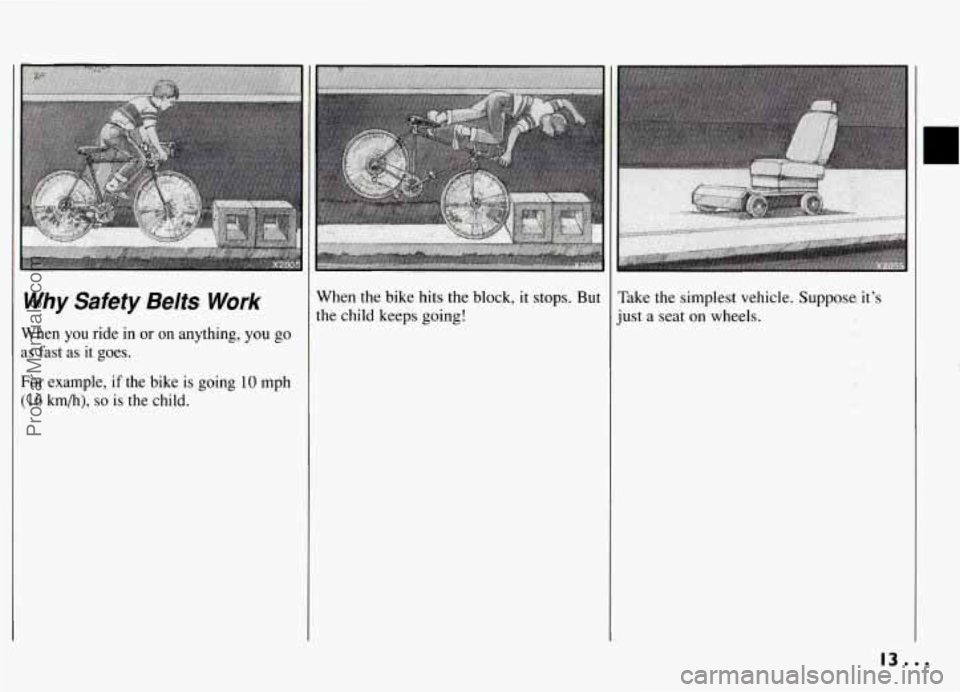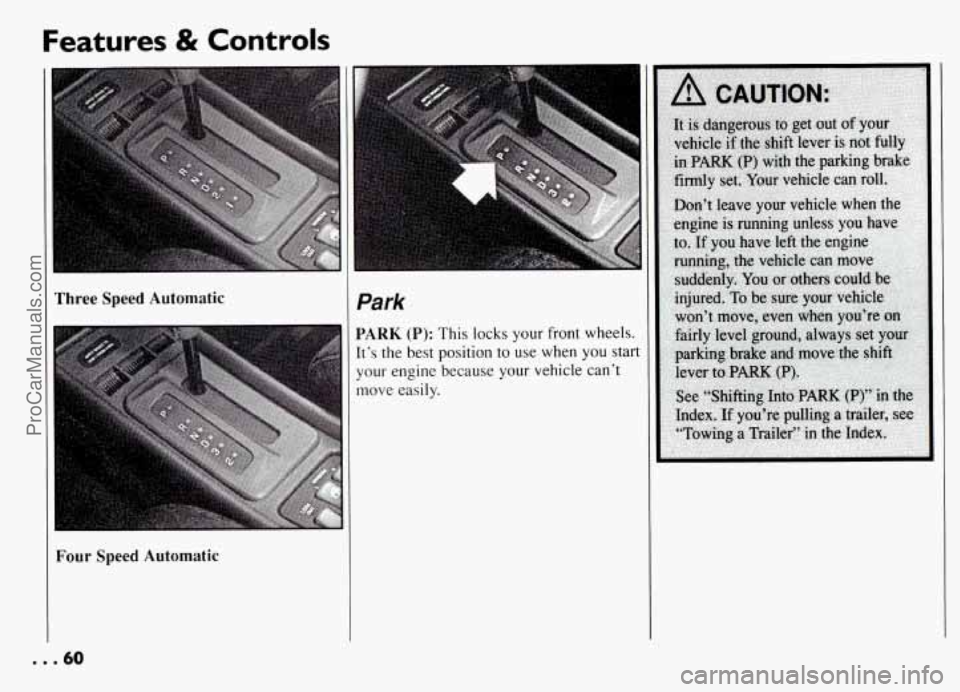1994 PONTIAC GRAND-AM wheel
[x] Cancel search: wheelPage 14 of 274

When you ride in or on anything, you go
as fast as it goes.
For example, if the 'bike is going 10 mph
( 16 km/h), so is the child.
When the bike hits the black, it stops. But
the child keeps going! Take the simplest vehicle. Suppose! it's
just
a seat on wheels.
..
,. .. * .i. ,
iii' ::
-$,!
13...
ProCarManuals.com
Page 24 of 274

-.
How The Air Bag System
Works
Where is the air bag?
The driver’s air bag is in the middle of the
steering wheel.
When is an air bag expected to inflate?
The air bag is designed to inflate in
moderate to severe frontal or near-frontal
crashes. The air bag will only inflate
if the
velocity of the impact is above the
designed threshold level. When impacting
straight into a wall that does not move or
deform, the threshold level for most
GM
vehicles is between 9 and 15 mph (14 and
23 km/h). However, this velocity
threshold depends on the vehicle design
and may be several miles-per-hour faster
or slower. In addition, this threshold
velocity will be considerably higher
if the
vehicle strikes an object such as a parked
car which will move and deform on
impact. The air bag is also not designed to
inflate in rollovers, side impacts, or rear
impacts where the inflation would provide
no occupant protection benefit.
In any particular crash, the determination
of whether ‘the air bag should have inflated
cannot be based solely on the level of
damage on the vehicle(s), Inflation is
determined by the angle of the impact and
the vehicle’s deceleration, of which vehicle
damage
is only one indication. Repair cost
is not a good indicator of whether an air
bag should have deployed.
What makes an air bag inflate?
In a frontal impact of sufficient severity, the
air bag sensing system detects that the
vehicle is suddenly stopping as a result of a
crash. The sensing system triggers a
chemical reaction
of the sodium azide
sealed in the inflator. The reaction produces
nitrogen gas, which inflates the cloth bag.
The inflator, cloth bag, and related
hardware are all part of the
air bag inklator
module packed inside the steering wheel.
How does an air bag restrain? ~
In moderate to severe frontal or
near-frontal collisions, even belted
occupants can contact the steering wheel.
The air bag supplements the protektion
provided by safety belts. Air.bags
distribute the force of the impact more
evenly over the occupant’s upper body,
stopping the occupant more gradually. But
air bags would not provide protection in
many types of collisions, including
rollovers and rear and side impacts,
primarily because an occupant’s motion is
not toward the air bag. Air bags should
never be regarded as anything more than a
supplement to safety belt protection in
moderate to severe frontal and near-frontal
:ollisions.
II
ProCarManuals.com
Page 25 of 274

Seats & Restraint Systems
How The Air Bag System
Works (CONT)
What will you see after an air bag
inflation?
After the air bag has inflated, it will then
quickly deflate, This occurs
so quickly
that some people may not even realize
that the air bag inflated. Some
components of the air bag module
in the
steering wheel hub may be hot for a short
time, but the portion of the bag that comes
into contact with you will not be hot to
the touch. There will be small amounts of
smoke and dust coming from vents in the
deflated air bag. The air bag will
not
impede the driver’s vision or ability to
steer the vehicle, nor will it hinder the
occupants from exiting the vehicle.
0 The air bag is designed to inflate only
once. After it inflates, you’ll need
some new parts for your air bag
system. If you don’t get them, the air
bag system won’t be there to help
protect you in another crash.
A new
system will include the air bag module
and possibly other parts. The service
manual has information about the
need to replace other parts.
Your vehicle is equipped with a
diagnostic module, which records
information about the air bag system
if the air bag deploys during a crash.
The module records information about
the readiness .of the system, which
sensors activated the deployment, and
whether the driver’s safety belt was in
use.
Let only qualified technicians work on
your air bag system. Improper service
can mean that your air bag system
won’t work properly. See your dealer
for service.
NOTICE:
If you damage the cover for the
driver’s air bag, it may not work
properly. You may have to replace
the air bag on the steering wheel.
Do not open or break the air bag
cover.
Is the smoke from an air bag inflation
harmful?
The particles emitted during air bag
inflation are not harmful to most people.
Some people with respiratory ailments
may experience difficulty breathing if
they’stay in the vehicle with the windows
closed’after air bag inflation.
So, if your
air bag inflates, you and any passengers
should exit the vehicle if and when it is
safe’to do
so. If you or your passengers
can’t get out of the vehicle, try to get
fresh air by opening a window, turning on
the fan, or opening
a door.
... 24
ProCarManuals.com
Page 53 of 274

Features & Controls
Battery Replacement
(CONK)
To Replace Batteries in the Remote
Keyless Entry:
1. Remove the screw from back cover.
2. Lift the front cover off, bottom half
first.
3. Remove and replace the two batteries
(2016).
4. Reassemble the transmitter.
5. Check the transmitter operation.
Tailgate Caution
. . 52
Theft
Vehicle theft is big business, especially in
some cities. Although your Pontiac has a
number of theft deterrent features, we
know that nothing we put on
it can make
it impossible to steal. However, there are
ways you can help.
Key in the Ignition
If you walk away from your vehicle with
the keys inside, it’s an easy target for joy
riders or professional thieves
-- so don’t
do
it.
When you park your Pontiac and open the
driver’s door, you’ll hear a chime
reminding you to remove your key from
the ignition and take
it with you. Always
do this. Your steering wheel will be
locked, and
so will your ignition. If you
have an automatic transaxle, taking your
key out also locks your transaxle. And
remember to lock the doors.
Parking at Night
Park in a lighted spot, close all windows
and lock your vehicle. Remember to keep
your valuables out of sight. Put them
in a
storage area, or take them with you.
ProCarManuals.com
Page 56 of 274

LOCK
ACCESSORY
I Ignition Switch-
Vith the ignition key in the ignition
witch, you can
turn the switch ‘to five
ositions:
,CCESSORE An “on” position in
lhich you can operate some of your
lectrical power accessories. Press
in the
;nition switch as you turn the top of
it
)ward you.
,OCK: The only position in which you
!n remove the key. This locks your
:cering wheel, ignition and transaxle
~n automatic models).
IFF: Unlocks the steering wheel,
;nition, and transaxle (on’ automatic
todels), but.does not send electrical
power to any accessories. Use this
position if your vehicle must be pushed or
towed, but never try
to push-start your
vehicle.
A warning’chime will sound if
you open the driver’s door when the
ignition is off and the key is in the
ignition.
RUN: An “on” position to which the
switch returns after you start your engine
and release the switch. The switch stays
in the RUN position when the engine is
running. But ‘even when the engine is not
running, you can use RUN io operate
your electrical power accessories,
and to
display
some instrument panel warning
lights.
START: Starts the engine. When the
engine starts, release the key. The ignition
switch
will return to RUN for normal
driving.
Note that even if the engine is not
running, ‘the positions
ACCESSORY and
RUN are “on” positions that allow you to
operate your electrical accessories, such
as the radio.
,.
Key Release Button
‘MANUAL TRANSAXLE)
The ignition key cannot be removed from
he ignition unless.the key release button
s used.
ro Remwe the Key:
rum the key to the OFF position. Press
he key release button while turning
the
Ley from OFF to LOCK. Keeping your
inger on
the button, pull the key straight
)Ut.
sa...
ProCarManuals.com
Page 57 of 274

Features & Controls
Key Release Button
(MANUAL TRANSAXLE) (CONT.)
NOTICE:
If your key seems stuck in LOCK
and you can’t turn it, be sure it is all
the.way in. If
it is, then turn the
steering wheel left and right while
you
turn the key hard. But turn the
key only
with your hand. Using a
tool to force
it could break the key
or the ignition switch.
If none of this
works, then your vehicle needs
service.
Starting Your Engine
Engines start differently. The 8th digit of
your Vehicle Identification Number (VIN)
shows
the code letter or number for your
engine. You
will find the VIN at the top
left
of your instrument panel. (See
”Vehicle Identification Number”
in the
Index.) Follow the proper steps to start
the engine.
Automatic transaxle
Move your shift lever to PARK (P) or
NEUTRAL (N). Your engine won’t start
in any other position -- that’s a safety
feature. To restart when you’re already
.EUTRAL (N) only.
Don’t try to shift to PARK (P) if
your Pontiac is moving. If you do,
you could damage the transaxle.
Shift to PARK (P) only when your
vehicle
is stopped.
Manual transaxle
Hold the clutch pedal to the floor, then
shift your gear selector to neutral while
starting the engine. Your vehicle won’t
start
if the clutch pedal is not all the way
down
-- that’s a safety feature.
Both Transaxles
To Start Your 2.3 Liter EnEine
(Codes
3. D or A):
1. Without pushing the accelerator pedal,
turn your ignition key to START.
When the engine starts, let
go of the
key. The idle speed
will go down as
your engine gets warm.
NOTICE:
Holding your key in START for
longer than
15 seconds at a time will
cause your battery to be drained
much sooner. And the excessive
heat can damage your starter motor.
ProCarManuals.com
Page 61 of 274

Features & Controls
Three Speed Automatic
Four Speed Automatic
I
Park
PARK (P): This locks your front wheels
[t’s the best position to use when
you sta
your engine because your vehicle can’t
move easily.
... 60
ProCarManuals.com
Page 62 of 274

Ensure the shift lever is fully in PARK (P)
range before starting the engine. Your
Pontiac has a brake-transaxle shift
interlock.
You have to fully apply your
regular brake before you can shift from
PARK (P) when the ignition key is in the
RUN position. If you cannot shift out of
PARK (P), ease pressure on
the shift
lever- push the shift lever all the way
into PARK (P)
- as you maintain brake
application. Then move
the shift lever
into the gear you wish. (Press the shift
lever button before moving the shift
lever.) See “Shifting
Out of PARK (P)”
later
in this section.
I
Reverse
REVERSE (R): Use this gear to back up.
NOTICE:
Shifting to REVERSE (R) while
your vehicle is moving forward
could damage your transaxle. Shift
to REVERSE only after your
vehicle is stopped.
To rock your vehicle back and forth to get
out of snow, ice or sand without
damaging your transaxle, see “If You’re
Stuck: In Sand, Mud, Ice or Snow” in the
Index.
Neutral
NEUTRAL (N): In this position,,your
engine doesn’t connect with the wheels.
To restart when you’re already moving,
use NEUTRAL
(N) only. Also, use
NEUTRAL when your vehicle is Geing
towed.
61 ...
ProCarManuals.com